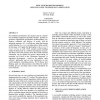1472 search results - page 23 / 295 » Technique Integration for Requirements Assessment |
81
Voted
VRST
1997
ACM
15 years 2 months ago
1997
ACM
Developing virtual reality (VR) applications which enable actual work over a period of time requires optimization of the most basic interactions, such as object manipulation, so t...
88
Voted
HAPTICS
2009
IEEE
15 years 2 months ago
2009
IEEE
Data-driven haptic rendering requires processing of raw recorded signals, which leads to high computational effort for large datasets. To achieve real-time performance, one possib...
76
Voted
SIGCSE
2006
ACM
15 years 4 months ago
2006
ACM
New accreditation requirements focus on education as a “continuous improvement process.” The most important part of such a process is that information gets fed back into the s...
80
Voted
WSC
2008
15 years 17 days ago
2008
For simulation practitioners, the common steps in a simulation modeling engagement are likely familiar: problem assessment, requirements specification, model building, verificatio...
MICCAI
2004
Springer
15 years 11 months ago
2004
Springer
In the framework of computer-assisted diagnosis, pulmonary airway investigation based on multi detector computed tomography (MDCT) requires to provide radiologists and clinicians w...

